Molecular Mechanisms of Resistance to Ionizing Radiation in S. cerevisiae and Its Relationship with Aging, Oxidative Stress, and Antioxidant Activity
Abstract
:1. Introduction
2. Materials and Methods
2.1. Study Strategy and Analysis
2.2. Text/Data Mining
- DNA repair mechanisms (DSB repair, HR, NHEJ, base excision repair, mismatch repair, etc.).
- DNA-damage checkpoint control proteins (mitosis entry checkpoint, telomere length regulation, etc.).
- Cell cycle division control (G1/S-specific cyclins, cell-cycle box factors, and regulatory proteins in response to radiation).
- Heat shock response.
- Proteins that relate cell proliferation with resistance to radiation.
- Regulatory proteins and post-replication repair ubiquitin-proteins in response to radiation.
- General transcription and DNA repair factors.
- Other processes related to radiation response (proteins involved in joint resistance to radiation and metals and/or drugs, helicases, and transcriptional coactivators).
2.3. Analysis of Gene–Gene Interaction Networks and Clusters Identification
2.4. Gene Ontology and KEGG Pathway Analysis
2.5. Enriched Ontology Clusters
2.6. Protein–Protein Interaction Analysis
2.7. Regulation Mechanisms
2.8. Human, Mouse, and Rat Homologous Genes and Their Comparison with More Specific Databases
3. Results
3.1. Text/Data Mining
3.2. Analysis of Gene–Gene Interaction Networks and Clusters Identification
3.3. Gene Ontology and KEGG Pathway Analysis
3.4. Enriched Ontology Clusters
3.5. Protein–Protein Interaction Analysis
3.6. Regulation Mechanisms
3.7. Human, Mouse, and Rat Homologous Genes and Their Comparison with More Specific Databases
4. Discussion
5. Conclusions
Author Contributions
Funding
Institutional Review Board Statement
Informed Consent Statement
Data Availability Statement
Conflicts of Interest
References
- Yang, C.-R.; Leskov, K.; Hosley-Eberlein, K.; Criswell, T.; Pink, J.J.; Kinsella, T.J.; Boothman, D.A. Nuclear clusterin/XIP8, an x-ray-induced Ku70-binding protein that signals cell death. Proc. Natl. Acad. Sci. USA 2000, 97, 5907–5912. [Google Scholar] [CrossRef]
- Sagkrioti, E.; Biz, G.M.; Takan, I.; Asfa, S.; Nikitaki, Z.; Zanni, V.; Kars, R.H.; Hellweg, C.E.; Azzam, E.I.; Logotheti, S.; et al. Radiation Type- and Dose-Specific Transcriptional Responses across Healthy and Diseased Mammalian Tissues. Antioxidants 2022, 11, 2286. [Google Scholar] [CrossRef]
- Fernández, J.S. The downfall of the linear non-threshold model. Rev. Española Med. Nuclear Imag. Mol. 2020, 39, 303–315. [Google Scholar] [CrossRef]
- Sonoda, E.; Hochegger, H.; Saberi, A.; Taniguchi, Y.; Takeda, S. Differential usage of non-homologous end-joining and homologous recombination in double strand break repair. DNA Repair 2006, 5, 1021–1029. [Google Scholar] [CrossRef]
- Hochegger, H.; Sonoda, E.; Takeda, S. Post-replication repair in DT40 cells: Translesion polymerases versus recombinases. Bioessays 2004, 26, 151–158. [Google Scholar] [CrossRef]
- Ito-Harashima, S.; Yagi, T. Unique molecular mechanisms for maintenance and alteration of genetic information in the budding yeast Saccharomyces cerevisiae. Genes Environ. 2017, 39, 28. [Google Scholar] [CrossRef]
- Cahill, D.; Connor, B.; Carney, J.P. Mechanisms of eukaryotic DNA double strand break repair. Front. Biosci. 2006, 11, 1958–1976. [Google Scholar] [CrossRef]
- Ruiz-Gómez, M.J.; Sendra-Portero, F.; Martínez-Morillo, M. Effect of 2.45 mT sinusoidal 50 Hz magnetic field on Saccharomyces cerevisiae strains deficient in DNA strand breaks repair. Int. J. Radiat. Biol. 2010, 86, 602–611. [Google Scholar] [CrossRef]
- Burgos-Molina, A.M.; Mercado-Sáenz, S.; Sendra-Portero, F.; Ruiz-Gómez, M.J. Effect of low frequency magnetic field on efficiency of chromosome break repair. Electromagn. Biol. Med. 2020, 39, 30–37. [Google Scholar] [CrossRef]
- Rowe, L.A.; Degtyareva, N.; Doetsch, P.W. Yap1: A DNA damage responder in Saccharomyces cerevisiae. Mech. Ageing Dev. 2012, 133, 147–156. [Google Scholar] [CrossRef]
- Schütz, R.; Kuratli, K.; Richard, N.; Stoll, C.; Schwager, J. Mitochondrial and glycolytic activity of UV-irradiated human keratinocytes and its stimulation by a Saccharomyces cerevisiae autolysate. J. Photochem. Photobiol. B 2016, 159, 142–148. [Google Scholar] [CrossRef]
- Vanderwaeren, L.; Dok, R.; Voordeckers, K.; Vandemaele, L.; Verstrepen, K.J.; Nuyts, S. An Integrated Approach Reveals DNA Damage and Proteotoxic Stress as Main Effects of Proton Radiation in S. cerevisiae. Int. J. Mol. Sci. 2022, 23, 5493. [Google Scholar] [CrossRef]
- Krisko, A.; Radman, M. Protein damage, ageing and age-related diseases. Open Biol. 2019, 9, 180249. [Google Scholar] [CrossRef]
- Guo, X.; Zhang, M.; Gao, Y.; Lu, D.; Li, W.; Zhou, L. Repair characteristics and time-dependent effects in response to heavy-ion beam irradiation in Saccharomyces cerevisiae: A comparison with X-ray irradiation. Appl. Microbiol. Biotechnol. 2020, 104, 4043–4057. [Google Scholar] [CrossRef]
- Wang, S.; Liu, C.; Ouyang, W.; Liu, Y.; Li, C.; Cheng, Y.; Su, Y.; Liu, C.; Yang, L.; Liu, Y.; et al. Common Genes Involved in Autophagy, Cellular Senescence and the Inflammatory Response in AMD and Drug Discovery Identified via Biomedical Databases. Transl. Vis. Sci. Technol. 2021, 10, 14. [Google Scholar] [CrossRef]
- Fu, W.; Cao, X.; An, T.; Zhao, H.; Zhang, J.; Li, D.; Jin, X.; Liu, B. Genome-wide identification of resistance genes and transcriptome regulation in yeast to accommodate ammonium toxicity. BMC Genom. 2022, 23, 514. [Google Scholar] [CrossRef]
- Baran, J.; Gerner, M.; Haeussler, M.; Nenadic, G.; Bergman, C.M. pubmed2ensembl: A Resource for Mining the Biological Literature on Genes. PLoS ONE 2011, 6, e24716. [Google Scholar] [CrossRef]
- Zhou, Y.; Zhou, B.; Pache, L.; Chang, M.; Khodabakhshi, A.H.; Tanaseichuk, O.; Benner, C.; Chanda, S.K. Metascape provides a biologist-oriented resource for the analysis of systems-level datasets. Nat. Commun. 2019, 10, 1523. [Google Scholar] [CrossRef]
- García-Moreno, A.; López-Domínguez, R.; Ramirez-Mena, A.; Pascual-Montano, A.; Aparicio-Puerta, E.; Hackenberg, M.; Carmona-Saez, P. GeneCodis 4: Expanding the modular enrichment analysis to regulatory elements. bioRxiv 2021. [Google Scholar] [CrossRef]
- Garcia-Moreno, A.; López-Domínguez, R.; Villatoro-García, J.A.; Ramirez-Mena, A.; Aparicio-Puerta, E.; Hackenberg, M.; Pascual-Montano, A.; Carmona-Saez, P. Functional Enrichment Analysis of Regulatory Elements. Biomedicines 2022, 10, 590. [Google Scholar] [CrossRef]
- Kanehisa, M.; Goto, S. KEGG: Kyoto Encyclopedia of Genes and Genomes. Nucleic Acids Res. 2000, 28, 27–30. [Google Scholar] [CrossRef] [PubMed]
- Kanehisa, M.; Sato, Y. KEGG Mapper for inferring cellular functions from protein sequences. Protein Sci. 2020, 29, 28–35. [Google Scholar] [CrossRef]
- Carmona-Saez, P.; Chagoyen, M.; Tirado, F.; Carazo, J.M.; Pascual-Montano, A. GENECODIS: A web-based tool for finding significant concurrent annotations in gene lists. Genome Biol. 2007, 8, R3. [Google Scholar] [CrossRef]
- Nogales-Cadenas, R.; Carmona-Saez, P.; Vazquez, M.; Vicente, C.; Yang, X.; Tirado, F.; Carazo, J.M.; Pascual-Montano, A. GeneCodis: Interpreting gene lists through enrichment analysis and integration of diverse biological information. Nucleic Acids Res. 2009, 37, W317–W322. [Google Scholar] [CrossRef]
- Tabas-Madrid, D.; Nogales-Cadenas, R.; Pascual-Montano, A. GeneCodis3: A non-redundant and modular enrichment analysis tool for functional genomics. Nucleic Acids Res. 2012, 40, W478–W483. [Google Scholar] [CrossRef] [PubMed]
- Liu, Y.; Zhang, M.; Liu, Z.; Li, S.; Liu, H.; Huang, R.; Yi, F.; Zhou, J. A strategy can be used to analyze intracellular interaction proteomics of cell-surface receptors. Amino Acids 2023, 55, 263–273. [Google Scholar] [CrossRef]
- Nguyen, H.D.; Kim, M.-S. The protective effects of curcumin on metabolic syndrome and its components: In-silico analysis for genes, transcription factors, and microRNAs involved. Arch. Biochem. Biophys. 2022, 727, 109326. [Google Scholar] [CrossRef]
- Szklarczyk, D.; Morris, J.H.; Cook, H.; Kuhn, M.; Wyder, S.; Simonovic, M.; Santos, A.; Doncheva, N.T.; Roth, A.; Bork, P.; et al. The STRING database in 2017: Quality-controlled protein-protein association networks, made broadly accessible. Nucleic Acids Res. 2017, 45, D362–D368. [Google Scholar] [CrossRef]
- Molon, M.; Zadrag-Tecza, R. Effect of temperature on replicative aging of the budding yeast Saccharomyces cerevisiae. Biogerontology 2015, 17, 347–357. [Google Scholar] [CrossRef]
- Tacutu, R.; Thornton, D.; Johnson, E.; Budovsky, A.; Barardo, D.; Craig, T.; Diana, E.; Lehmann, G.; Toren, D.; Wang, J.; et al. Human Ageing Genomic Resources: New and updated databases. Nucleic Acids Res. 2018, 46, D1083–D1090. [Google Scholar] [CrossRef]
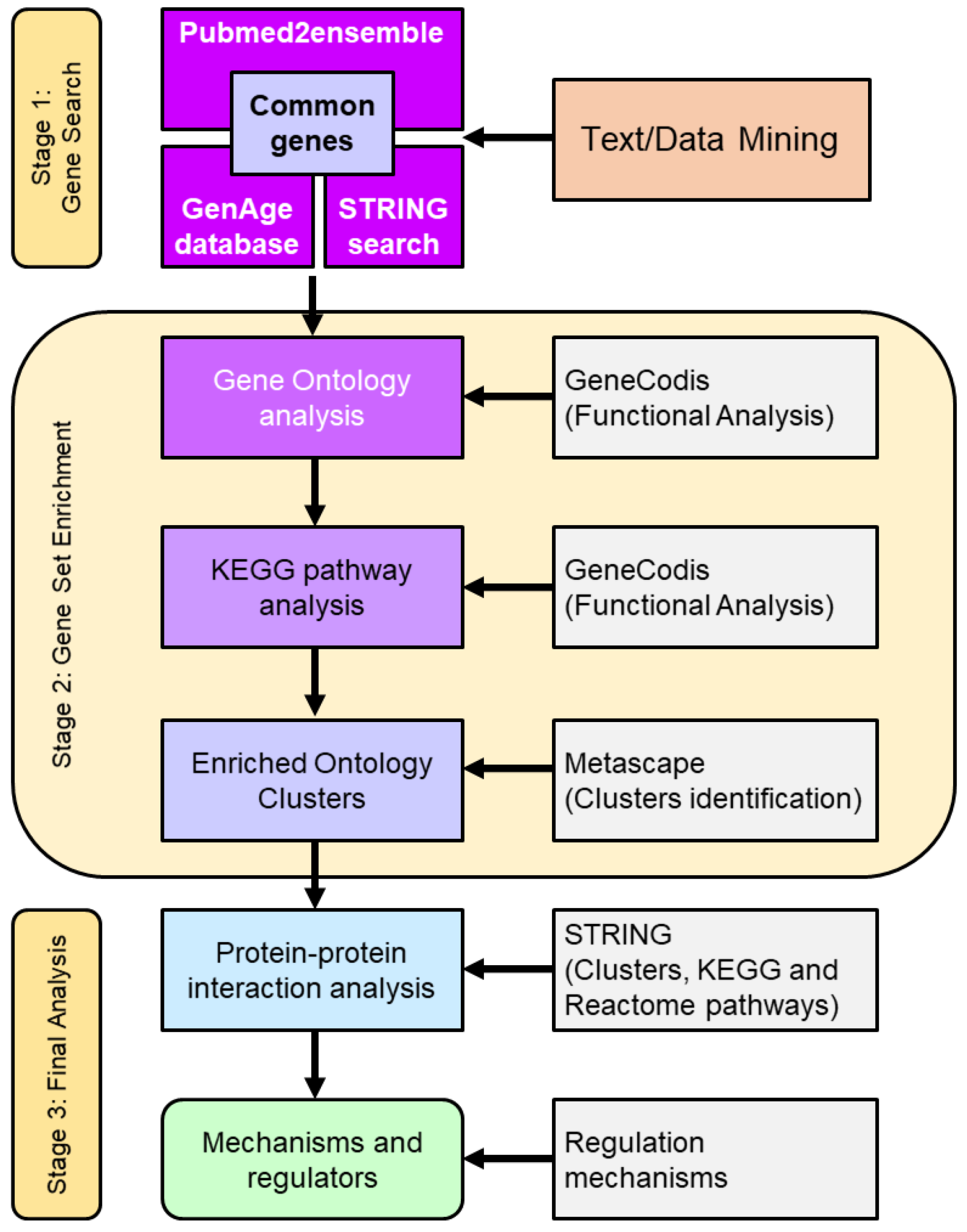
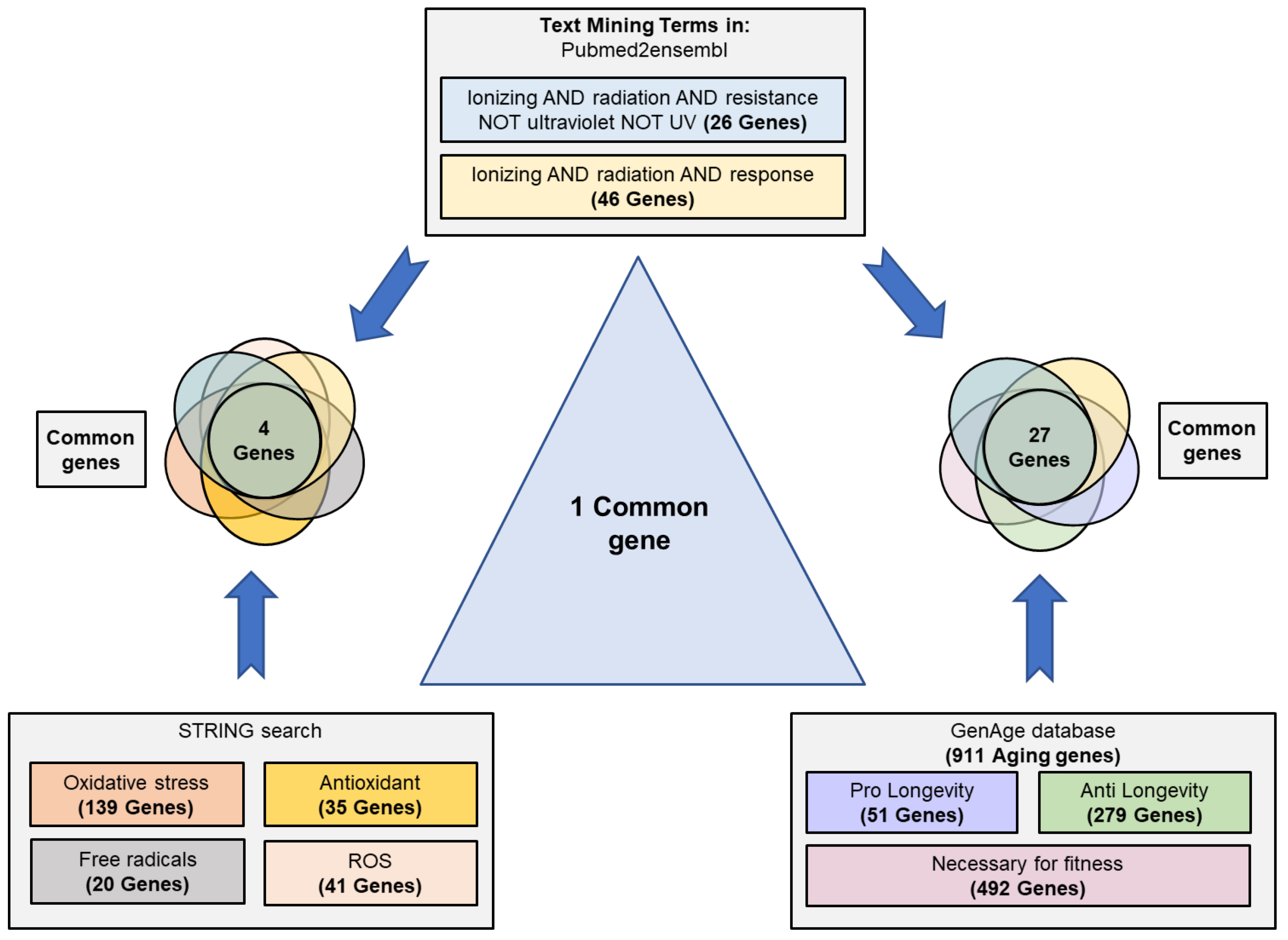
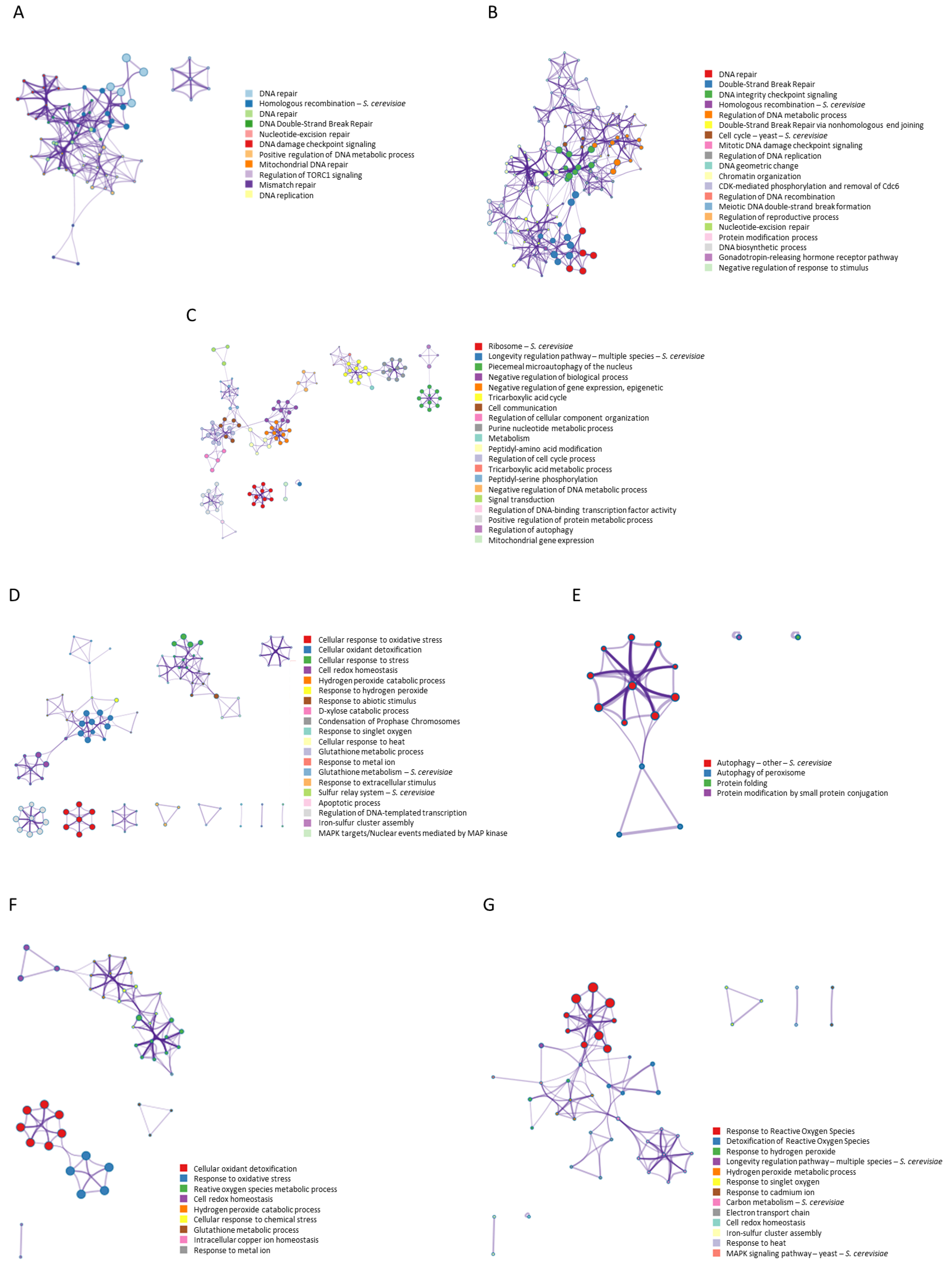
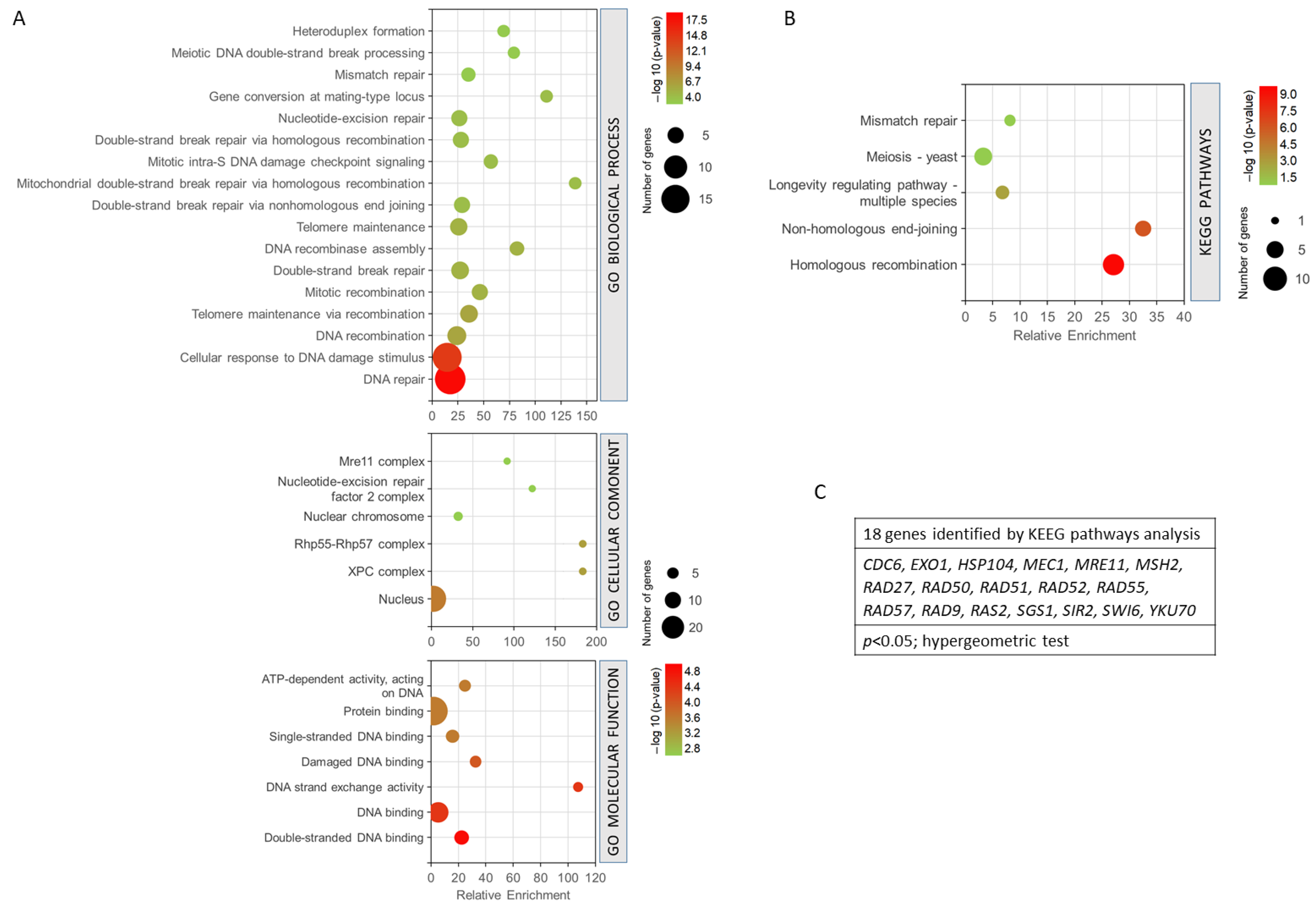

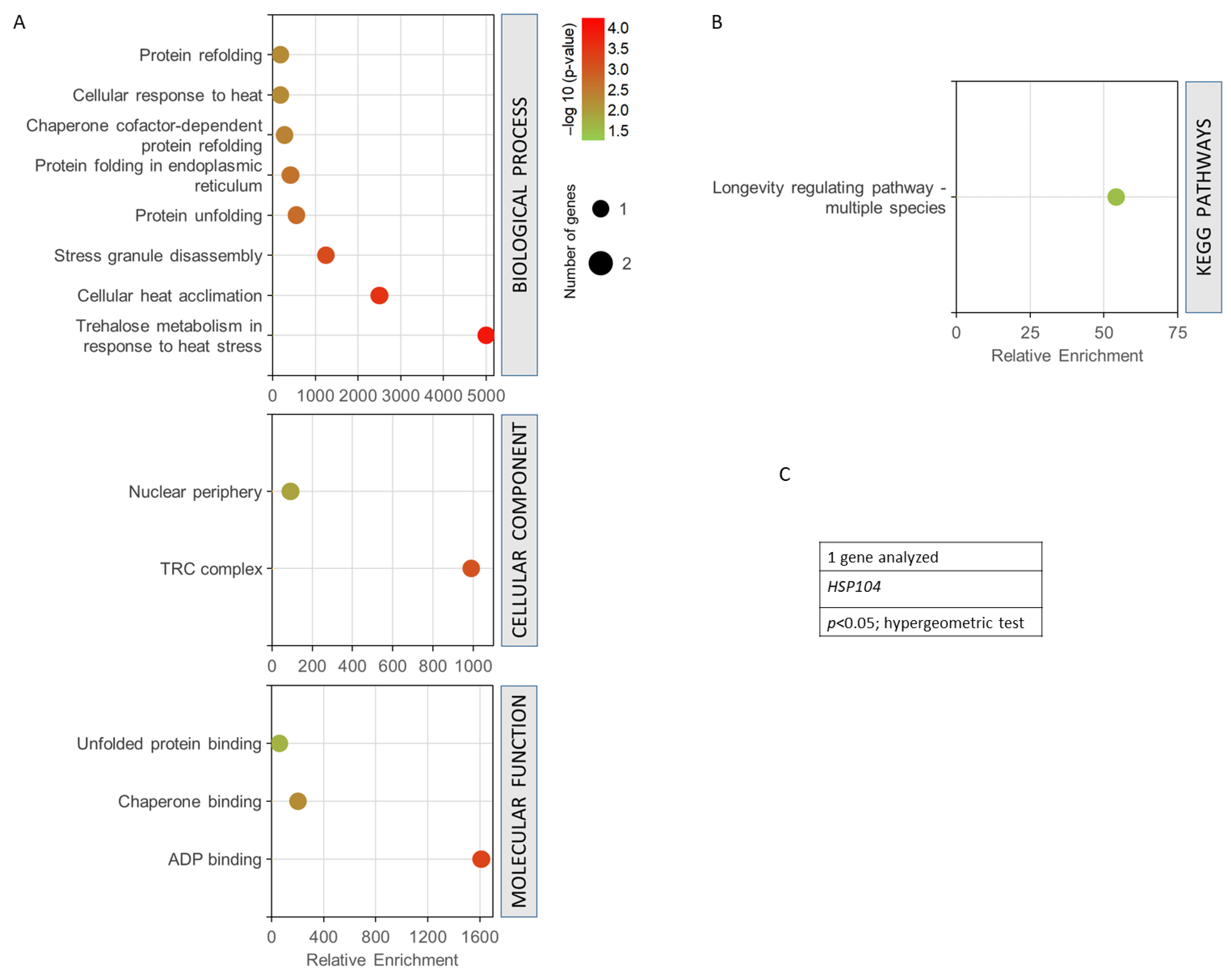
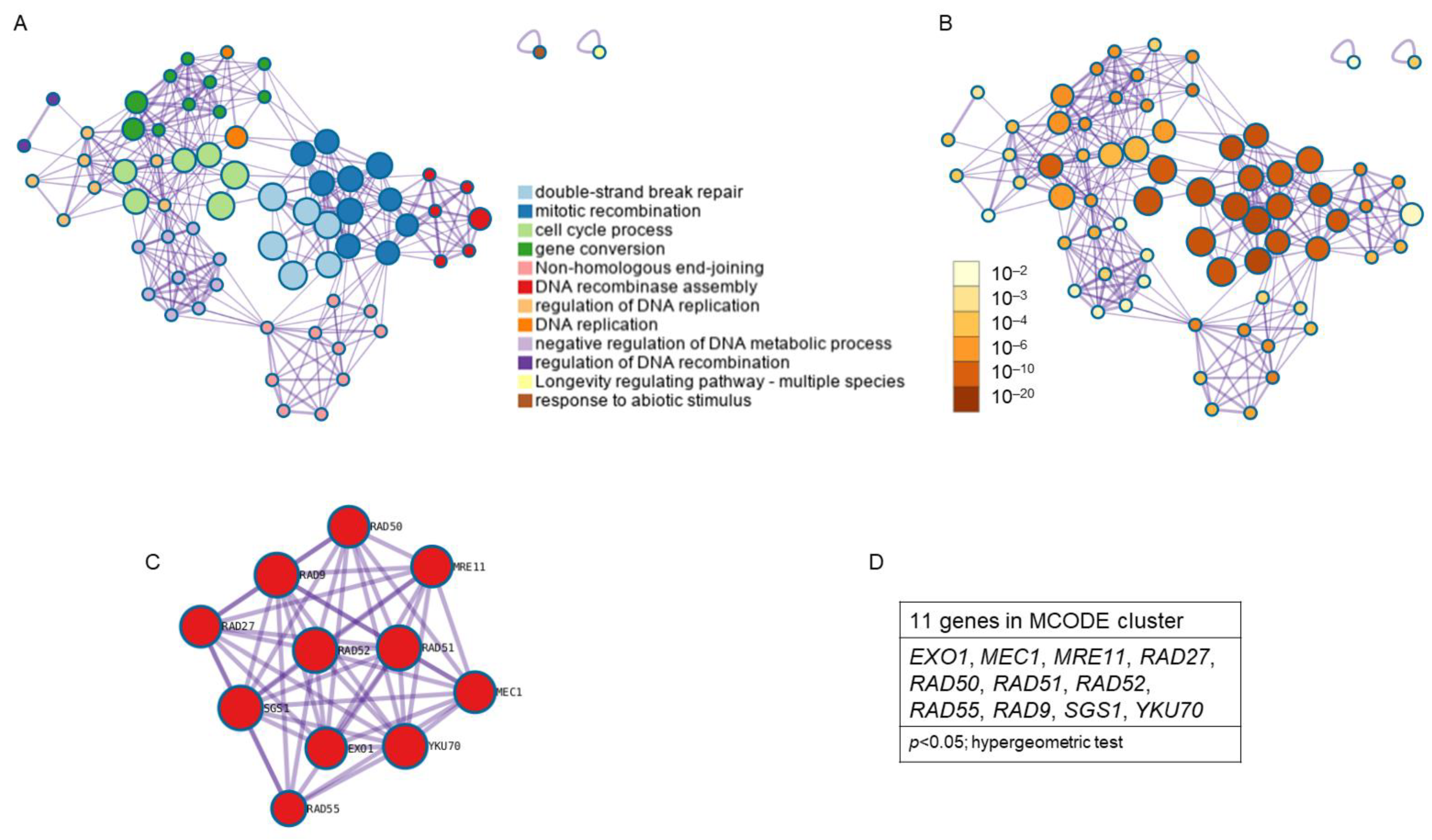
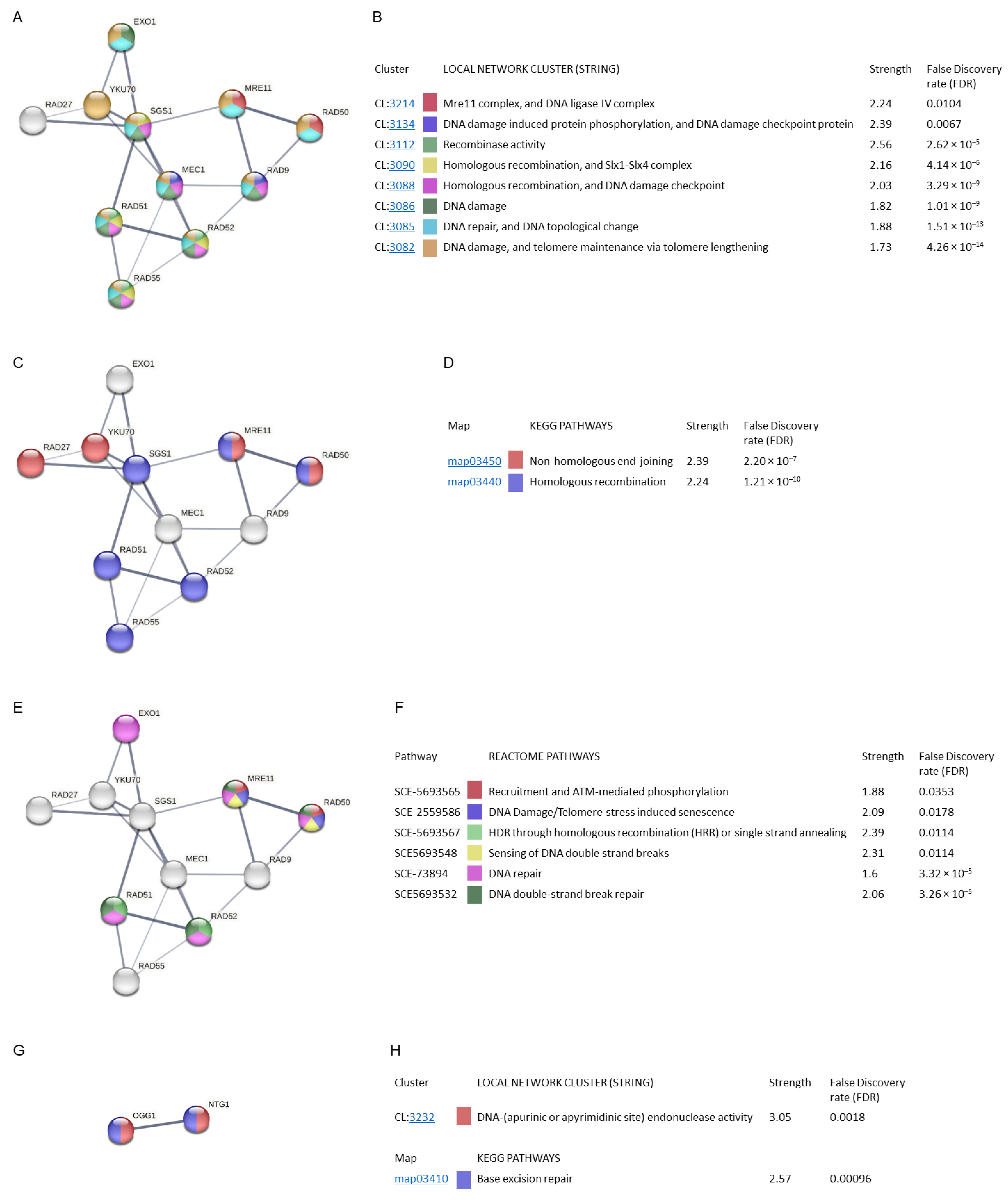
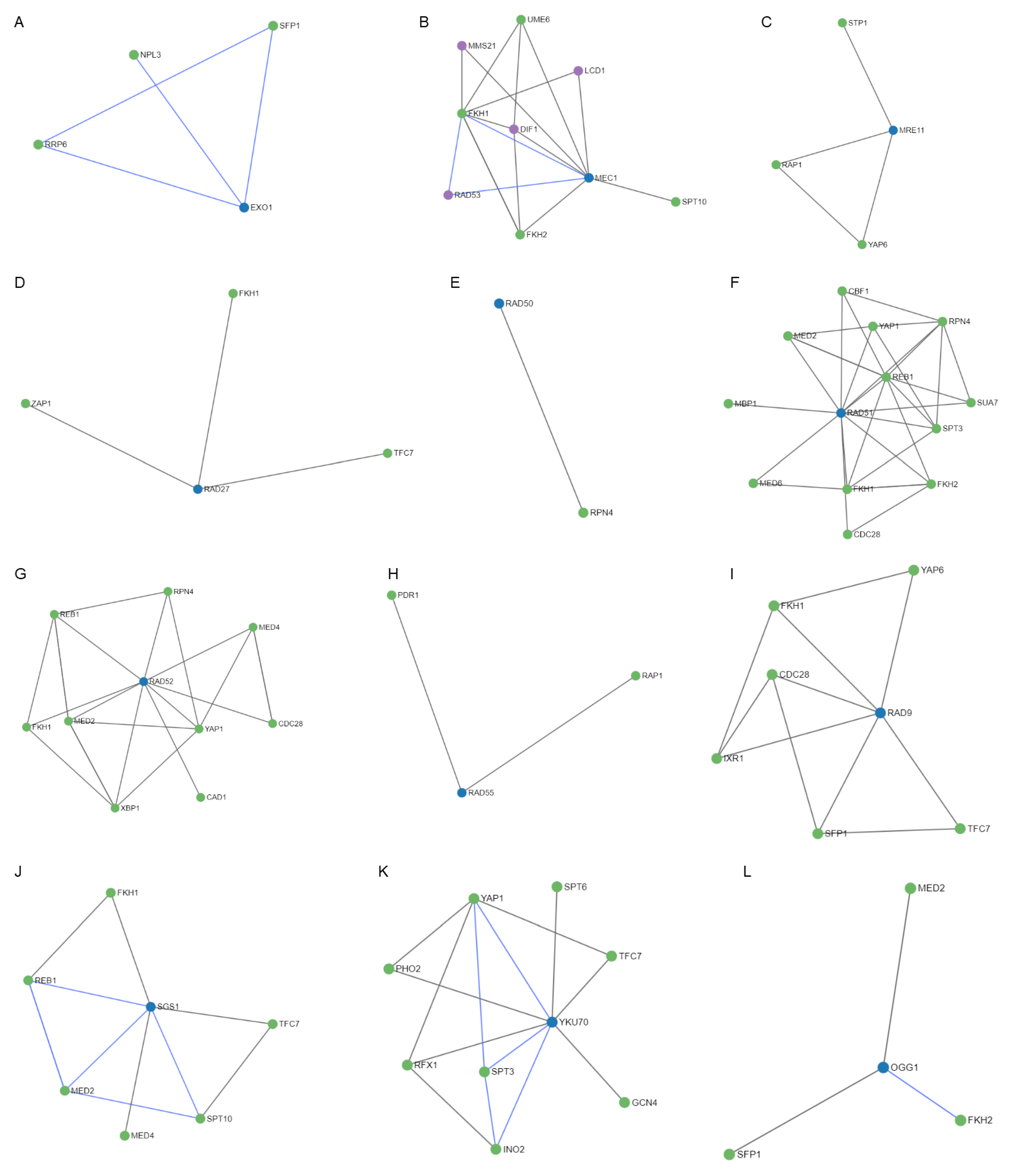

| Radiation Resistance/Response versus Aging | Radiation Resistance/Response versus Oxidative Stress, Free Radicals, ROS and Antioxidant Activity | All Phenomena |
|---|---|---|
| CAT5, CDC6, DOT1, EXO1, HSP104, MEC1, MRE11, MSH2, NTH1, RAD10, RAD27, RAD34, RAD4, RAD50, RAD51, RAD52, RAD55, RAD57, RAD9, RAS2, RCK2, SAS3, SGS1, SIR2, SWI6, VPS8, YKU70 | NTG1, SIT4, OGG1, HSP104 | HSP104 |
| Regulator | Description | Regulator Type | Regulation of |
|---|---|---|---|
| AFT1 | Activator of Ferrous Transport | Transcription factor | Transcription |
| AFT2 | Activator of Fe (iron) Transcription | Transcription factor | Transcription |
| BUR6 | Bypass UAS Requirement | Transcription factor | Transcription in response to heat |
| CAD1 | AP-1-like basic leucine zipper (bZIP) transcriptional activator | Transcription factor | Transcription in response to hydrogen peroxide |
| CAT8 | CATabolite repression | Transcription factor | Transcription |
| CBF1 | Basic helix–loop–helix (bHLH) protein | Transcription factor | Transcription |
| CDC28 | Cyclin-dependent kinase (CDK) catalytic subunit | Protein modifier | Protein activity during G2/M transition of mitotic cell cycle |
| CUP2 | Copper-binding transcription factor | Transcription factor | Transcription |
| FKH1 | Forkhead family transcription factor | Transcription factor | Transcription |
| FKH2 | Forkhead family transcription factor | Transcription factor | Transcription |
| FLO8 | FLOcculation | Transcription factor | Transcription |
| GCN4 | bZIP transcriptional activator of amino acid biosynthetic genes | Transcription factor | Negative transcription in respone to boron-containing substance levels |
| GCN5 | General Control Nonderepressible | Transcription factor | Transcription in response to heat |
| HSF1 | Heat Shock transcription Factor | Transcription factor | Positive Transcription in response to heat |
| INO2 | Transcription factor | Transcription factor | Transcription in response to heat |
| IXR1 | Transcriptional repressor that regulates hypoxic genes during normoxia | Transcription factor | Transcription |
| MAC1 | Metal binding ACtivator | Transcription factor | Transcription |
| MBP1 | Transcription factor | Transcription factor | Transcription |
| MED2 | Subunit of the RNA polymerase II mediator complex | Transcription factor | Transcription in response to heat |
| MED4 | Subunit of the RNA polymerase II mediator complex | Transcription factor | Transcription in response to heat |
| MED6 | Subunit of the RNA polymerase II mediator complex | Transcription factor | Transcription in response to heat |
| NCB2 | Negative Cofactor B | Transcription factor | Transcription in response to heat |
| NPL3 | RNA-binding protein | RNA-binding protein | Positive RNA stability |
| PDR1 | Transcription factor that regulates the pleiotropic drug response | Transcription factor | Transcription |
| PHO2 | Homeobox transcription factor | Transcription factor | Transcription |
| RAP1 | Essential DNA-binding transcription regulator that binds many loci | Transcription factor | Transcription |
| REB1 | RNA polymerase I enhancer binding protein | Transcription factor | Transcription in response to heat |
| RFX1 | Major transcriptional repressor of DNA-damage-regulated genes | Transcription factor | Transcription in response to heat |
| RGM1 | Putative zinc finger DNA binding transcription factor | Transcription factor | Transcription |
| RGR1 | Resistant to Glucose Repression | Transcription factor | Transcription in response to heat |
| RIM101 | Regulator of IME2 | Transcription factor | Transcription |
| RPD3 | Reduced Potassium Dependency | Transcription factor | Transcription |
| RPN4 | Transcription factor that stimulates expression of proteasome genes | Transcription factor | Positive transcription during regulation of response to DNA damage stimulus |
| RRP6 | Nuclear exosome exonuclease component | RNA-binding protein | Negative RNA stability |
| SFP1 | Regulates transcription of ribosomal protein and biogenesis genes | Transcription factor | Transcription in response to stress |
| SPT10 | Histone H3 acetylase with a role in transcriptional regulation | Chromatin modifier | Transcription |
| SPT3 | Subunit of the SAGA and SAGA-like transcriptional regulatory complexes | Transcription factor | Transcription in response to heat |
| SPT6 | Histone chaperone | Transcription factor | Transcription in response to heat |
| SPT7 | SuPpressor of Ty’s | Transcription factor | Transcription in response to heat |
| SRB5 | Suppressor of RNA polymerase B | Transcription factor | Transcription in response to heat |
| STP1 | Transcription factor | Transcription factor | Transcription in response to heat |
| SUA7 | Transcription factor TFIIB | Transcription factor | Transcription in response to heat |
| SWI4 | SWItching deficient | Transcription factor | Transcription |
| TFC7 | RNA pol III transcription initiation factor complex (TFIIIC) subunit | Transcription factor | Transcription in response to heat |
| TUP1 | dTMP-UPtake | Transcription factor | Transcription in response to heat |
| UME6 | Rpd3L histone deacetylase complex subunit | Transcription factor | Transcription in response to heat |
| WTM2 | WD repeat containing Transcriptional Modulator | Transcription factor | Transcription |
| XBP1 | Transcriptional repressor | Transcription factor | Transcription in response to heat |
| YAP1 | Basic leucine zipper (bZIP) transcription factor | Transcription factor | Transcription in response to heat |
| YAP6 | Basic leucine zipper (bZIP) transcription factor | Transcription factor | Transcription in response to heat |
| YHP1 | Yeast Homeo-Protein | Transcription factor | Transcription |
| ZAP1 | Zinc-regulated transcription factor | Transcription factor | Positive transcription in response to zinc ion starvation |
| Phenomena | S. cerevisiae Gene | Homologous Human Gene | Description/Function |
|---|---|---|---|
| Ionizing radiation response/resistance and aging | EXO1 | EXO1 | Exonuclease 1. Involved in mismatch repair and recombination |
| MEC1 | ATR and PRKDC | ATR serine/threonine kinase and protein kinase, DNA-activated, catalytic subunit. ATR can promote DNA repair, recombination, and apoptosis. PRKDC participates in DNA double-strand break repair and recombination | |
| MRE11 | MRE11 | Double-strand break repair nuclease. Involved in homologous recombination, telomere length maintenance, and DNA double-strand break repair | |
| RAD27 | FEN1 and GEN1 | Flap structure-specific endonuclease 1 and GEN1 Holliday junction 5’ flap endonuclease. FEN1 removes 5’ overhanging flaps in DNA repair and processes the 5’ ends of Okazaki fragments in lagging strand DNA synthesis. GEN 1 is involved in resolution of Holliday junctions, during homologous recombination and double-strand break repair | |
| RAD50 | RAD50 | Double-strand break repair protein. Required for nonhomologous joining of DNA ends | |
| RAD51 | RAD51 | Recombinase. Involved in the homologous recombination and repair of DNA | |
| RAD52 | RAD52 | RAD52 homolog, DNA repair protein. Important for DNA double-strand break repair and homologous recombination | |
| RAD55 | – | – | |
| RAD9 | – | – | |
| SGS1 | RECQL, RECQL4, WRN, RECQL5, and BLM | Helicases. Involved in DNA repair, including mismatch repair, nucleotide excision repair, and direct repair; in the maintenance of genome stability, replication, transcription, and telomere maintenance | |
| YKU70 | XRCC6 | X-ray repair cross complementing 6. Involved in the repair of nonhomologous DNA ends | |
| Response/resistance to radiation and oxidative stress, free radicals, ROS, and antioxidant activity | NTG1 | – | – |
| OGG1 | OGG1 | 8-oxoguanine DNA glycosylase. Responsible for the excision of 8-oxoguanine, a mutagenic base byproduct which occurs as a result of exposure to reactive oxygen | |
| All phenomena | HSP104 | CLPB | ClpB family mitochondrial disaggregase. Involved in various processes including DNA replication, protein degradation, and reactivation of misfolded proteins |
| Phenomena | S. cerevisiae Gene | Homologous Mus musculus Gene | Description of Mus musculus Gene | Homologous Rattus norvegicus Gene | Description of Rattus norvegicus Gene |
|---|---|---|---|---|---|
| Ionizing radiation response/resistance and aging | EXO1 | Exo1 | Exonuclease 1 | Exo1 | Exonuclease 1 |
| MEC1 | Atr and Prkdc | Ataxia telangiectasia and Rad3 related; Protein kinase, DNA-activated, catalytic polypeptide | Atr and Prkdc | ATR serine/threonine kinase and protein kinase, DNA-activated, catalytic subunit | |
| MRE11 | Mre11a | MRE11A homolog A, double-strand break repair nuclease | Mre11 | MRE11 homolog, double-strand break repair nuclease | |
| RAD27 | Fen1 and Gen1 | Flap structure specific endonuclease 1 and GEN1, Holliday junction 5’ flap endonuclease | Fen1 and Gen1 | Flap structure-specific endonuclease 1 and GEN1 Holliday junction 5’ flap endonuclease | |
| RAD50 | Rad50 | RAD50 double-strand break repair protein | Rad50 | RAD50 double-strand break repair protein | |
| RAD51 | Rad51 | RAD51 recombinase | Rad51 | RAD51 recombinase | |
| RAD52 | Rad52 | RAD52 homolog, DNA repair protein | Rad52 | RAD52 homolog, DNA repair protein | |
| RAD55 | – | – | – | – | |
| RAD9 | – | – | – | – | |
| SGS1 | Recql4, Wrn, Recql, Blm, and Recql5 | RecQ protein-like 4, Werner syndrome RecQ like helicase, RecQ protein-like, Bloom syndrome, RecQ-like helicase, and RecQ protein-like 5 | Recql, Recql5, Wrn, Recql4, and Blm | RecQ-like helicase, RecQ-like helicase 5, WRN RecQ-like helicase, RecQ-like helicase 4, and BLM RecQ-like helicase | |
| YKU70 | Xrcc6 | X-ray repair complementing defective repair in Chinese hamster cells 6 | Xrcc6 | X-ray repair cross complementing 6 | |
| Response/resistance to radiation and oxidative stress, free radicals, ROS, and antioxidant activity | NTG1 | – | – | – | – |
| OGG1 | Ogg1 | 8-oxoguanine DNA-glycosylase 1 | Ogg1 | 8-oxoguanine DNA glycosylase | |
| All phenomena | HSP104 | Clpb | ClpB caseinolytic peptidase B | Clpb | ClpB family mitochondrial disaggregase |
| Human | Mouse | ||||||
|---|---|---|---|---|---|---|---|
| Gen | EXO1 | RAD51 | FEN1 | Exo1 | Rad51 | Clpb | |
| Expression status | Down | Down | Down | Down | Up | Up | Up |
| Tissue/Cell line | iPSC-derived cardiomyocytes | Peripheral blood | iPSC-derived cardiomyocytes | Peripheral blood | Brain | Blood cells | Blood cells |
| Type of radiation | X-rays | X-rays | X-rays | X-rays | Protons | X-rays | X-rays |
| Time after irradiation | 48 h | 24 h | 48 h | 24 h | 0 h | 7 days | 24 h |
| LET (keV/μm) | 2.1 | – | 2.1 | – | – | 2 | 2 |
| Energy (kV) | 240 | 120 | 240 | 120 | – | 250 | 250 |
| Dose (Gy) | 5 | 2 | 5 | 2 | 2 | 4 | 4 |
| Dose rate (Gy/min.) | 1 | 2.015 | 1 | 2.015 | – | 1.23 | 1.23 |
| DSB (num./Gy/Gbp) | 12.78 | 12.78 | 12.78 | 12.78 | – | 12.78 | 12.78 |
| Gene | Description and Functions | Main Role | Lifespan Effect |
|---|---|---|---|
| EXO1 | Exodeoxyribonuclease 1; 5′-3′ exonuclease and flap-endonuclease; involved in recombination, double-strand break repair, MMS2 error-free branch of the post replication (PRR) pathway, and DNA mismatch repair; role in telomere maintenance; member of the Rad2p nuclease family, with conserved N and I nuclease domains; relative distribution to the nucleus increases upon DNA replication stress | DNA repair | Reduced |
| HSP104 | Chaperone ATPase; Disaggregase; heat shock protein that cooperates with Ydj1p (Hsp40) and Ssa1p (Hsp70) to refold and reactivate previously denatured, aggregated proteins; responsive to stresses including heat, ethanol, and sodium arsenite; involved in [PSI+] propagation; protein becomes more abundant and forms cytoplasmic foci in response to DNA replication stress; potentiated Hsp104p variants decrease TDP-43 proteotoxicity by eliminating its cytoplasmic aggregation; Belongs to the ClpA/ClpB family | Reactivate denatured and aggregated proteins | 40% reduced |
| MEC1 | Serine/threonine-protein kinase MEC1; Genome integrity checkpoint protein and PI kinase superfamily member; Mec1p and Dun1p function in same pathway to regulate dNTP pools and telomere length; signal transducer required for cell cycle arrest and transcriptional responses to damaged or unreplicated DNA; facilitates replication fork progression and regulates P-body formation under replication stress; promotes interhomolog recombination by phosphorylating Hop1p; associates with shortened, dysfunctional telomeres; belongs to the PI3/PI4-kinase family and the ATM subfamily | Involved in replication stress and DNA damage | 66% reduced |
| MRE11 | Double-strand break repair protein MRE11; nuclease subunit of the MRX complex with Rad50p and Xrs2p; complex functions in repair of DNA double-strand breaks and in telomere stability; Mre11p associates with Ser/Thr-rich ORFs in premeiotic phase; nuclease activity required for MRX function; widely conserved; forms nuclear foci upon DNA replication stress; belongs to the MRE11/RAD32 family | Meiotic recombination | 15–50% reduced |
| RAD27 | Flap endonuclease 1; 5′ to 3′ exonuclease, 5′ flap endonuclease; required for Okazaki fragment processing and maturation, for long-patch base-excision repair and large loop repair (LLR), ribonucleotide excision repair; member of the S. pombe RAD2/FEN1 family; relocalizes to the cytosol in response to hypoxia | Genomic stability | 50% reduced |
| RAD50 | DNA repair protein RAD50; subunit of MRX complex with Mre11p and Xrs2p; complex is involved in processing double-strand DNA breaks in vegetative cells, initiation of meiotic DSBs, telomere maintenance, and nonhomologous end joining; forms nuclear foci upon DNA replication stress; belongs to the SMC family and RAD50 subfamily | Genomic stability | 70% reduced |
| RAD51 | DNA repair protein RAD51; strand exchange protein; forms a helical filament with DNA that searches for homology; involved in the recombinational repair of double-strand breaks in DNA during vegetative growth and meiosis; homolog of Dmc1p and bacterial RecA protein | Recombination repair | 40% reduced |
| RAD52 | DNA repair and recombination protein RAD52; protein that stimulates strand exchange; stimulates strand exchange by facilitating Rad51p binding to single-stranded DNA; anneals complementary single-stranded DNA; involved in the repair of double-strand breaks in DNA during vegetative growth and meiosis and UV induced sister chromatid recombination; belongs to the RAD52 family | DNA repair | 70% reduced |
| RAD55 | Putative DNA-dependent atpase rad55; DNA repair protein RAD55; protein that stimulates strand exchange; stimulates strand exchange by stabilizing the binding of Rad51p to single-stranded DNA; involved in the recombinational repair of double-strand breaks in DNA during vegetative growth and meiosis; forms heterodimer with Rad57p; belongs to the RecA family and RAD55 subfamily | DNA repair | 60% reduced/increased |
| RAD9 | DNA damage-dependent checkpoint protein; required for cell-cycle arrest in G1/S, intra-S, and G2/M; plays a role in postreplication repair (PRR) pathway; transmits checkpoint signal by activating Rad53p and Chk1p; hyperphosphorylated by Mec1p and Tel1p; multiple cyclin-dependent kinase consensus sites and the C-terminal BRCT domain contribute to DNA damage checkpoint activation; Rad9p Chk1-activating Domain (CAD) is phosphorylated at multiple sites by Cdc28p/Clb2p | Involved in DNA damage response | 50% reduced |
| SGS1 | ATP-dependent helicase SGS1; RecQ family nucleolar DNA helicase; role in genome integrity maintenance, chromosome synapsis, and meiotic joint molecule/crossover formation; stimulates activity of Top3p; rapidly lost in response to rapamycin in Rrd1p-dependent manner; forms nuclear foci upon DNA replication stress; yeast SGS1 complements mutations in human homolog BLM implicated in Bloom syndrome; also similar to human WRN implicated in Werner syndrome; human BLM and WRN can each complement yeast null mutant; belongs to the helicase family and RecQ subfamily | Involved in maintenance of genome integrity | 30% reduced |
| YKU70 | ATP-dependent DNA helicase II subunit 1; subunit of the telomeric Ku complex (Yku70p-Yku80p); involved in telomere length maintenance, structure, and telomere position effect; required for localization of telomerase ribonucleoprotein to nucleus via interaction with the TLC1 guide RNA; relocates to sites of double-strand cleavage to promote nonhomologous end joining during DSB repair | Telomere length maintenance | Reduced |
Disclaimer/Publisher’s Note: The statements, opinions and data contained in all publications are solely those of the individual author(s) and contributor(s) and not of MDPI and/or the editor(s). MDPI and/or the editor(s) disclaim responsibility for any injury to people or property resulting from any ideas, methods, instructions or products referred to in the content. |
© 2023 by the authors. Licensee MDPI, Basel, Switzerland. This article is an open access article distributed under the terms and conditions of the Creative Commons Attribution (CC BY) license (https://creativecommons.org/licenses/by/4.0/).
Share and Cite
González-Vidal, A.; Mercado-Sáenz, S.; Burgos-Molina, A.M.; Alamilla-Presuel, J.C.; Alcaraz, M.; Sendra-Portero, F.; Ruiz-Gómez, M.J. Molecular Mechanisms of Resistance to Ionizing Radiation in S. cerevisiae and Its Relationship with Aging, Oxidative Stress, and Antioxidant Activity. Antioxidants 2023, 12, 1690. https://doi.org/10.3390/antiox12091690
González-Vidal A, Mercado-Sáenz S, Burgos-Molina AM, Alamilla-Presuel JC, Alcaraz M, Sendra-Portero F, Ruiz-Gómez MJ. Molecular Mechanisms of Resistance to Ionizing Radiation in S. cerevisiae and Its Relationship with Aging, Oxidative Stress, and Antioxidant Activity. Antioxidants. 2023; 12(9):1690. https://doi.org/10.3390/antiox12091690
Chicago/Turabian StyleGonzález-Vidal, Alejandro, Silvia Mercado-Sáenz, Antonio M. Burgos-Molina, Juan C. Alamilla-Presuel, Miguel Alcaraz, Francisco Sendra-Portero, and Miguel J. Ruiz-Gómez. 2023. "Molecular Mechanisms of Resistance to Ionizing Radiation in S. cerevisiae and Its Relationship with Aging, Oxidative Stress, and Antioxidant Activity" Antioxidants 12, no. 9: 1690. https://doi.org/10.3390/antiox12091690
APA StyleGonzález-Vidal, A., Mercado-Sáenz, S., Burgos-Molina, A. M., Alamilla-Presuel, J. C., Alcaraz, M., Sendra-Portero, F., & Ruiz-Gómez, M. J. (2023). Molecular Mechanisms of Resistance to Ionizing Radiation in S. cerevisiae and Its Relationship with Aging, Oxidative Stress, and Antioxidant Activity. Antioxidants, 12(9), 1690. https://doi.org/10.3390/antiox12091690








